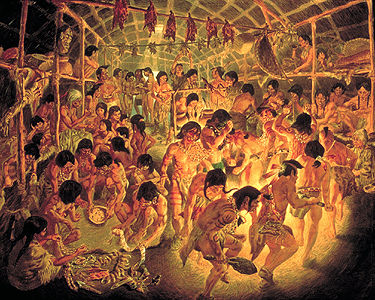Tionontati (also known as Petun) are an Iroquoian-speaking Indigenous people, closely related to the Huron-Wendat. The French called them Petun because they were known for cultivating tobacco or petún. The people call themselves Tionontati. After war with the Haudenosaunee in the mid-1600s, Tionontati and some other survivors, including the Attignawantan (a Huron-Wendat people) and the Wenrohronon (or Wenro), joined to become the Wendat, now known as the Wyandotte (or Wyandot) Nation. Today, the Wyandotte Nation is a federally recognized tribe of Oklahoma in the United States. There are also Wyandotte communities in Michigan (Wyandot of Anderdon Nation) and Kansas (Wyandot Nation of Kansas).
Traditional Territory
At the time of European contact, the Tionontati occupied eight to ten villages located below the Niagara Escarpment along the southwest margin of Georgian Bay. Their precontact population is uncertain but appears to have numbered several thousand. (See also Indigenous Territory.)
Traditional Life
The Tionontati differed little from the Huron-Wendat, who lived one day's journey to the northeast of their territory. It appears from historical accounts and archaeology that the Tionontati were formed in late prehistoric times by a union of Iroquoian-speakers moving west from Wendake and other Iroquoian groups from the areas that are now Toronto or Hamilton. (See also Eastern Woodlands Indigenous Peoples in Canada.)
The Tionontati maintained trading relationships with the Neutral and Huron-Wendat, and with the Algonquian-speaking Odawa and Nipissing. They had walled villages that were occupied year-round and that contained numerous longhouses. The population subsisted by cultivating corn, beans and squash, as well as by hunting and fishing.
The Tionontati are one of the lesser known Indigenous groups in Canada, partly because they were not numerous, but primarily because they were overshadowed in 17th-century European attention by the larger and politically more important Huron Confederacy.

Dispersal and Creation of Wyandotte Nation
The Tionontati were dispersed along with the Huron-Wendat by the Haudenosaunee in 1649. The surviving Tionontati joined with some refugee Indigenous peoples and made extensive journeys through the midwestern United States. They eventually settled in the 1850s in Oklahoma, where descendants of both groups now reside under the name Wyandotte, a form of the original Huron name for themselves (Wendat).
Culture and Language
Wyandotte culture includes the clan system, which has been used to designate social groups whose members trace descent from their ancestors. Wyandotte people celebrate their culture by participating in various events and ceremonies, including powwows.
The Wyandotte speak a Northern Iroquoian language. Today, Wyandotte peoples strive to protect and promote their language. (See also Indigenous Languages in Canada.)
Wendat Confederacy
In 1999, the leaders of the four contemporary Indigenous nations that descended from the original Huron-Wendat people — Wyandotte Nation (Oklahoma), Wyandot Nation of Kansas, Wyandot Nation of Anderdon Nation (Michigan) and Huron-Wendat Nation (Wendake, Quebec) — signed a document that reaffirmed their connection to one another as the Wendat Confederacy.

 Share on Facebook
Share on Facebook Share on X
Share on X Share by Email
Share by Email Share on Google Classroom
Share on Google Classroom





